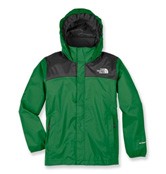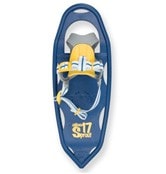Snowshoeing is one of the easiest and least-expensive ways for families to enjoy snowy winter days. Your kids don't need to be athletic or even outdoorsy to enjoy walking in snowshoes—but the fun of the activity will encourage both.
So how do you get them started?
Rule # 1: Keep Them Comfortable
Since snowshoeing involves floating on top of the snow, kids stay relatively dry (unless they make a snow angel, which is OK, too). Kids warm up quickly once they start moving, so layering with long underwear and a lightweight shell jacket is usually best for cold, wet conditions. On mild days, it's possible to snowshoe in just shorts and a T-shirt.
A snowshoeing outfit may consist of:

Jacket: For most winter days, a lightweight, water- and wind-resistant shell jacket is all they need (when worn over a long underwear top). Insulated jackets (e.g., goose down) are generally too warm for snowshoe trips of any distance—especially if there is uphill terrain involved.
Pants: Ideally, these feature a synthetic or wool material that's brushed on the inside, with a tight water-repelling weave (soft shell) on the outside. They are loose enough to allow movement but are not baggy. Alternatively, a child can simply wear long underwear under lightweight, waterproof/breathable shell pants. Lightly insulated children's ski pants work fine but may get too hot on a long snowshoe adventure. Avoid jeans and other cotton pants.
Long underwear: Even on cold days, walking at a snail's pace warms up a little body. For frosty conditions, put a lightweight, next-to-skin base layer under a shell. Choose wool or synthetic fabrics that wick moisture and dry quickly (never cotton, as it gets cold when wet). Both the bottoms and top should be close-fitting but not constricting.
Insulation layer: If your excursion includes a stop for lunch or a snack, pack a wool sweater, fleece jacket or lightweight down coat. Your child won't need this layer while walking but will appreciate the warmth on rest breaks.
Socks: Pick socks of wool or synthetic fibers (no cotton). Make sure they fit with the child's boots or shoes. Hiking socks that extend just above the calf work fine, as do ski or snowboard socks. Light padding underfoot and at the front of ankles and shins helps to cushion young feet and ankles.
Gloves: Go with a light pair of synthetic or wool gloves. Reinforced palms will help with durability and water resistance. For chilly days, remember that mittens are warmer than gloves. Add insulating, waterproof/breathable shell gloves for very cold, wet conditions.
Hat: A lightweight wool or synthetic cap is best for chilly weather and snack breaks. The most important guideline: Get a good fit.
Accessories: Bring a good child-specific pack. Even small children can carry a pack with an extra jacket, water bottle and snack. Make sure the pack fits correctly—best are those with padded shoulder straps and, for older kids, a light waistbelt and sternum strap. For longer trips, bring along a small insulated bottle filled with hot cocoa.
Snowshoes: Rent or Buy?
Renting snowshoes for children (and adults) is a great way to try the sport. If you rent, bring along the footwear that you plan on wearing so you can make sure the bindings fit correctly.
Youth snowshoes are fairly inexpensive (generally $30 to $70, compared to $100-$300 for adult models), so it makes sense to buy snowshoes if you plan on multiple outings. Also, by having snowshoes on hand, you and your family are more likely to get out and use them.
Snowshoe Gear Shopping Tips

Snowshoes: Youth snowshoes tend to be one size fits all—with the size of shoe more dependent upon the weight of the child than size of the foot. Bindings are easily adjustable and accommodate multiple types of footwear (and growing feet). Once a child is over 80 or 90 pounds, the best bet is to choose a snowshoe designed for women. They are lighter, narrower and shorter than standard unisex snowshoes and, since they use fewer materials, less expensive, too.
Tip: When fitting the binding on the shoe or boot, make sure the straps are snug, but not so tight that they interfere with circulation.
Footwear: Most snowshoe bindings accommodate anything from sneakers to ski boots, but your best choice is lightweight, insulated winter boots with good ankle flex. Hiking boots or trail shoes also work, especially if they have waterproof or water-resistant uppers.
Gaiters: A gaiter provides a waterproof seal between the top of the boot and bottom of the pants. Most cover the laces on a boot (with a strap underneath to hold it in place) and extend to calf or knee height. A well-fitting gaiter won't let snow creep in the top of the boot or soak pant legs. Since snowshoes inevitably sink in a few inches with each step (more with deep powder), gaiters help keep kids warm and dry.
Poles: Anyone can snowshoe without poles, but they make it easier to move over unpredictable terrain. Kids can use alpine ski poles or trekking poles—the ideal fit is for arms to be at a 90-degree angle when holding the hand grip. Big baskets are better as they don't sink as far into the snow and provide a larger platform for balance. Most shops rent poles along with snowshoes. If you are buying poles for kids, consider ones with adjustable shafts so they can be extended as your child grows.
Tips for Starting Out

- Snowshoeing is easy to learn. Generally, no lessons are needed—if you can walk, you can snowshoe. It's best to learn on flat terrain. Many ski resorts have snowshoe-specific trails that follow snow-covered roads. Golf courses in snowy regions often cater to snowshoers (and cross-country skiers).
- Consider joining a snowshoe group. You and your child may expand your horizons of what is possible by exploring unknown trails, making new friends and refining technique.
- Snowshoes don't go in reverse. Snowshoes are designed to move forward, not backward. If you step back, the pointy tail drives into the snow, which generally leads to a fall. Instead of backing up, make a U-turn.
- Practice at home. Have your child put on and take off snowshoes at home (walking on grass is fine). Practice walking forward and making a U-turn. Kids often like to imitate a penguin (a slightly wider-than-normal stance) to accommodate for the width of the shoes.
- Try some hills. Most snowshoes are better at going up hills rather than traversing them. (Snowshoes need to be set flat with each stride; trying to kick in an edge doesn't work). Once a child can walk comfortably on flat terrain, pick a short trail (1 or 2 miles) with rolling hills to conquer.
- Avoid ski tracks: Many snowshoe paths share the same trails as cross-country skiers. Always take care to not step on ski tracks.
Kids' Snowshoeing FAQs

Q: Can we bring our dog snowshoeing?
A: Dogs typically love snow. And, with the exception of most national parks, the vast majority of trails in state and national forests and on BLM land allow dogs. Leash laws are usually posted at the trailhead, but you can also check the website of the specific park or land-management agency. Consider dog booties for your 4-legged friend—they protect paws from sharp ice crystals and cold.
Q: How safe is snowshoeing?
A: In terms of fall potential, snowshoeing is a very safe activity. Use poles to help with balance. Teach your child to steer clear of treewells and cliffs. Getting lost is always a concern with children, so talk about staying on trails, keeping with the group and staying put if lost. As the group leader, you should always leave word with someone about the day's plans. If you are unsure of where you are going, walk to a good turnaround point and follow your trail back. Avalanche hazards are also of concern in the backcountry—even kids can benefit from an avalanche safety course.
Q: Which is better for eye protection, sunglasses or goggles?
A: If it is snowing, goggles are preferable. On mild, sunny days, kid-specific sport sunglasses work well. Buy an inexpensive sunglass retainer that suspends the sunglasses around the child's neck when not in use.
Q: I notice that snowshoes have little grippy teeth on the bottom. What are they for?
A: Those grippy teeth are mini crampons. They are designed to bite into the snow and ice for better traction. More expensive adult snowshoes may have very spiky crampons used to climb steeper, more difficult terrain.
For more information, see the REI Expert Advice How to Choose Snowshoes article.
Remember: Safety is your responsibility. No internet article or video can replace proper instruction and experience—this article is intended solely as supplemental information. Be sure you're practiced in proper techniques and safety requirements before you engage in any outdoors activity.
